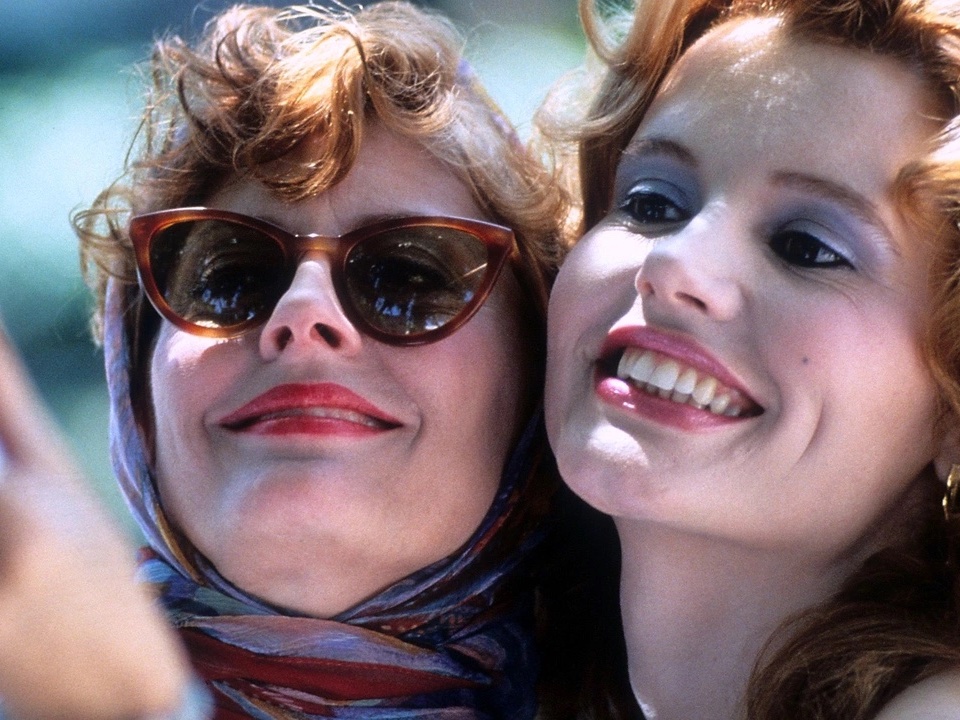
Meek housewife Thelma joins her friend Louise (Susan Sarandon), an independent waitress, on a short fishing trip. However, their trip becomes a flight from the law when Louise shoots and kills a man who tries to rape Thelma at a bar. Louise flees to Mexico, and Thelma decides to tag along.
EN
“After a rather slow beginning, this prosy film turns poetic; and when that happens, we’re no longer passive bystanders but active participants, along for the ride morally as well as physically. It’s questionable how much of the credit for this belongs to director Ridley Scott, whose production company made this movie. So far Scott has turned out one eye-popping cult movie, Blade Runner, which was substantially altered from his own cut, and several more or less forgettable features: two respectable genre exercises (Alien and Someone to Watch Over Me), a so-so literary adaptation (The Duellists), a fluffy department-store Christmas window display (Legend), and an offensive anti-Japanese thriller (Black Rain). He’s not exactly an auteur–this former director of commercials brings a stylish sense of lighting, framing, and monumentality to a variety of visual subjects, but he needs a good script as badly as a musician needs an instrument. He seems to have lucked out this time. Callie Khouri’s screenplay (her feature debut) and the performances of Davis and Sarandon provide him with both an engine and a body; he provides the snazzy paint job. In other words, without the stellar work of these three women, he’d be lost. [...]”
Jonathan Rosenbaum1
“They say Scott is a ‘visual’ director, which is only really half an insult. One could even just about mount an argument on the alternative auteurship of Thelma & Louise for its British cameraman, Adrian Biddle. His vivid location photography (accompanied by Hans Zimmer’s bluegrass-infused score with occasional Vangelis synth-stylings) elevates the film to the level of spectacle Khouri always had in mind. One particular left to right dolly shot, when the women pick up Pitt in the Thunderbird and head off the parking lot, turning left onto the highway, is sensual and magnificent, and it chimes with those numerous passages of the film which place the audience in the back seat behind the fugitives, or in a convoy, cheering them on. The final sequences shot in Moab, Utah, a favorite location of John Ford (Fort Apache, Cheyenne Autumn) but unused in a major Hollywood film since George Stevens’ The Greatest Story Ever Told in 1965, have a caramelized, elegiac quality which crystallize the film’s commitment to a myth-making ending. If Scott’s stylistic art direction is largely as one might expect (overly backlit interiors; various plumes of smoke/dust/vapor emanating from somewhere or other; use of rain hoses when it’s clearly cloudless and 100 degrees blazing sunshine), it is as producer that he really succeeds here: incorporating and parsing Khouri’s input (which was, in Scott’s own words, "vociferous") and assembling apposite technicians and actors, all in the cause of making her labor of love a reality. [...]
[W]hat really emerges from Thelma & Louise after twenty four years is a [...] valuable and potent manifesto, for what might be called ‘bread and roses’ feminism. Khouri doesn’t waste too long on a plea for bread (for women to receive equal treatment and respect) because in today’s world that should be a given. Her protagonists want roses too: to laugh and drink and fuck and misbehave – to share in life’s glories... and just for once, if it’s not too much to ask, to drive the car.”
Julien Allen2
- 1Jonathan Rosenbaum, “Poetry in Motion,” Chicago Reader, 6 June 1991.
- 2Julien Allen, “Drive Angry. Callie Khouri’s Thelma & Louise,” Reverse Shot, 10 November 2015.

